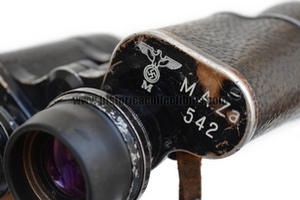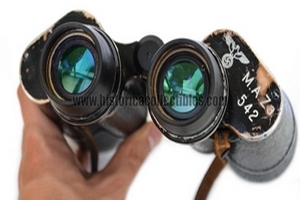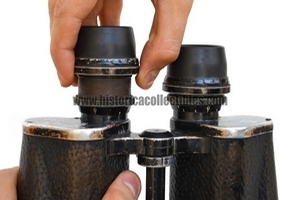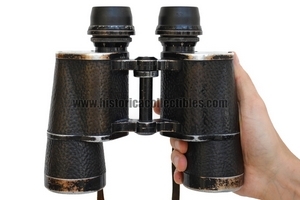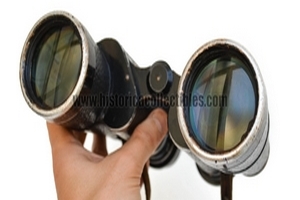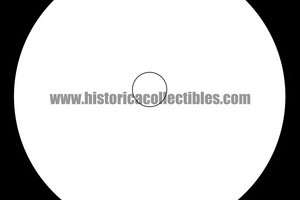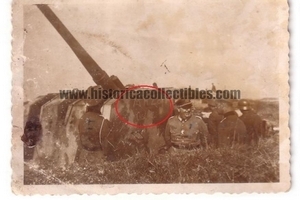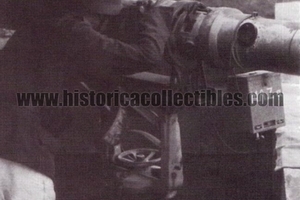Doppelfernrohr 7x50 M.A.Za. Carl Zeiss Gasmask Marine Artillerie Zeugamt, Kriegsmarine, 1939
7x50 binoculars produced by Carl Zeiss in Jena in 1939 in only 100 examples, with serial number 1892329, specifically assigned to the M.A.Za., or acronym "Marine Artillerie Zeugamt": they were in fact anti-ship coastal artillery emplacements of the Kriegsmarine. These binoculars, as can be seen from what is written on the right eyepiece plate, the letter "M" (Navy) with the "Reichsadler" identifies acceptance by the Kriegsmarine, assigning it to the district/zone "N. 3542 ( Unfortunately, to date it has not been possible to assign a geographical location to these codes).
On the left eyepiece plate the letter "T", or “Transparenzbelag”, indicates that the lenses are coated with an anti-reflection treatment which, thanks to this innovation, improved the transmission of light in the objectives by 80%. This system was developed and patented on November 1, 1935 by Aleksander Smakula, member of the Zeiss staff in Jena since 1934. Finally, "D.F. 7x50", stands for "Doppelfernrohr" which means binoculars with 7 magnifications and 50 mm diameter objective lenses.
It is equipped with special eyepieces called "Gasmask Okularen", rare, as they are perfectly intact, which have the function of being able to rest the eye completely and guarantee that constant distance necessary to view the entire image. In fact, if we remove the Gas Mask eyepieces and try to rest our eyes on the eyepieces, the same thing happens as looking through a sniper scope: if we do not respect the exact distance and centrality of vision on the lenses we will not be able to observe in a “perfect circle” the framed image.
The term Gas Mask was given to this version of "eyepieces" precisely because of the total isolation to which the eye is subject. In fact, just as happens with the gas mask once worn, one is totally isolated from external factors and in the specific case of these eyepieces, the observer was guaranteed a longer vision over time as he did not have the nuisance of dust especially the wind, factors which forced the observer to lose continuity of observation due to blinking and in the case of a "Marine Artillerie Zeugamt" position it was fundamental both in one direction or the other.
The 7x50 Gas Mask binoculars have slightly convex lenses with a larger diameter than the common 7x50 in order to allow a wider field of view and the size of the lenses brings more light to the observer's eyes resulting in clearer and more visible images bright.
Carl Zeiss takes its name from its founder, Carl Zeiss, who on November 17, 1846 chose the small town of Jena, in Thuringia, as the location for his precision optical equipment factory. Thanks to the severe quality control that Carl Zeiss imposed on his products, going so far as to personally destroy the microscopes that did not pass the tests, the newly formed Zeiss became the official supplier of the University of Jena and received the gold medal of the industrial exhibition in 1861 of Thuringia as the best research instrument produced in Germany, awarded to the Stand I microscope of 1857.
In 1866 the thousandth microscope was produced and the name Zeiss became known throughout European scientific circles. Thanks to studies on the Porro prism, in 1893 Abbe patented double prism binoculars, which accentuated the perception of depth. The mass production of Zeiss binoculars began in 1894, already at the beginning of the twentieth century more than 30,000 were made, at the beginning of the First World War the quota had risen to 500,000 and, at the end of the Second World War, as many as 2,260,000 were produced binoculars for the civil and military market.
Models were made starting from 4x11 mm to 12x40 mm, up to real giants such as the 80 mm and 100 mm. Thanks to studies conducted on the perception of light in low light situations, it was demonstrated that the average dilation of the pupil in an adult is approximately 7 mm. For this reason, the 7x50 mm model was introduced in 1910 and remained on the market until 1917 with few changes to the materials used. In 1926, following the post-war crisis of the First World War with the Treaty of Versailles which bankrupted many important German companies, Zeiss purchased "C.P. GOERZ" and founded Zeiss Ikon in 1926. In 1937 Zeiss had commercial contacts and factories in more than 29 countries around the world.
From '33 Zeiss acquired interest from the Nazi regime, which balanced production towards military instruments. It successfully produced binoculars with wide-angle optics for military use, pressure-resistant optical systems for U-boats, periscope binoculars for targeting tanks. Furthermore, Zeiss cameras were mounted on the V2s for remote sensing operations of the English coasts.
On 1 November 1935, Zeiss, in the figure of Alexander Smakula, patented a process for the treatment of optical glass with extraordinary results in terms of light transmission. Remained a military secret until 1939, it was adopted on binoculars to reduce ghost images and internal reflections. During the Second World War, there were numerous bombings against the Zeiss factories.
Jena was bombed several times by the Allies starting in 1944. Stuttgart was razed to the ground, although the Contessa-Nettel factory suffered little damage. The bombing of Dresden, in addition to devastating the city, also caused considerable damage to the Zeiss Ikon headquarters.
On April 13, 1945, American military forces entered Jena, surprising themselves that the bombing had not caused any significant damage. The main planetarium was in ruins, while the factories remained operational.

